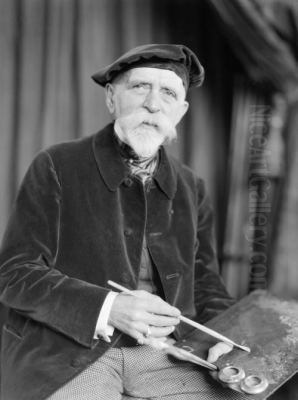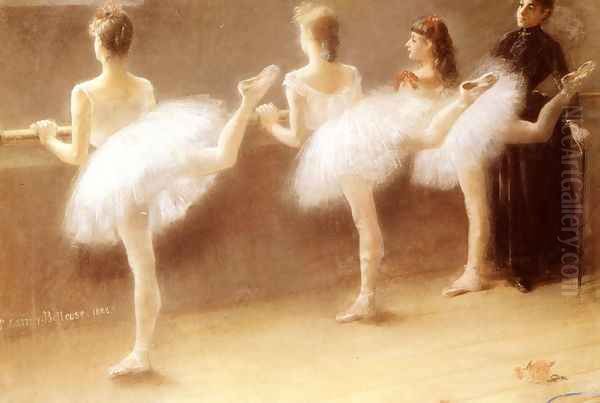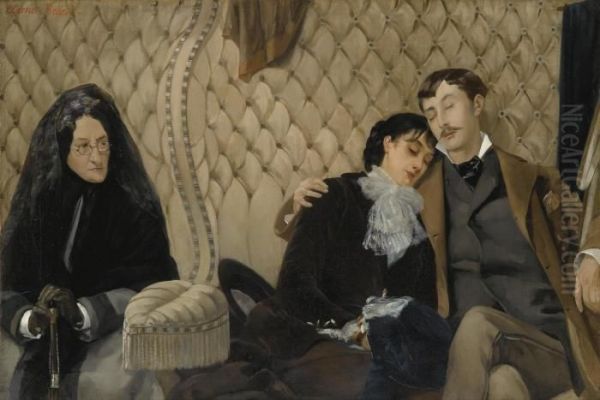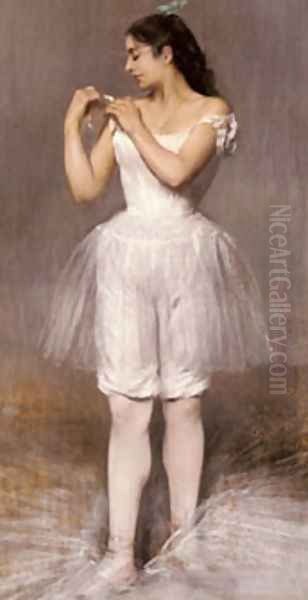
Pierre Carrier-Belleuse stands as a significant figure in French art during the late nineteenth and early twentieth centuries. Born into an artistic dynasty, he carved his own niche, distinct from his famous sculptor father, becoming renowned for his graceful depictions of Parisian life, particularly the world of ballet and theatre. His work, primarily in painting and pastel, captures the elegance, fashion, and fleeting moments of the Belle Époque with a refined and observant eye. While perhaps not an avant-garde revolutionary, Carrier-Belleuse was a master craftsman whose art provides a valuable window into the society and aesthetics of his time.
A Legacy of Art: Family and Early Formation
Pierre-Gérard Carrier-Belleuse was born in Paris on January 29, 1851. His father was the highly successful and influential sculptor Albert-Ernest Carrier-Belleuse (1824-1887), a dominant figure in Second Empire and early Third Republic art. Albert-Ernest was known for his versatile output, ranging from monumental public commissions and portrait busts to decorative objects and designs for the renowned Sèvres porcelain manufactory, where he served as artistic director. He enjoyed imperial patronage under Napoleon III and his studio was a hub of activity, famously employing a young Auguste Rodin for several years. Pierre's mother was Louise-Anne Adnot, though some sources mention Caroline Picasso (this might be a confusion or relate to another family member).
Growing up in such an environment meant Pierre was immersed in art from his earliest years. The constant presence of sculpting, design, and discussion about aesthetics undoubtedly shaped his path. It was natural, therefore, that he would pursue formal artistic training. He enrolled at the prestigious École des Beaux-Arts in Paris, the cornerstone of academic art education in France.

At the École, Pierre Carrier-Belleuse studied under influential masters. Chief among them was Alexandre Cabanel (1823-1889), a leading figure of the academic tradition, celebrated for his historical, mythological, and portrait paintings, including the famous The Birth of Venus (1863) which was purchased by Napoleon III. Cabanel emphasized classical composition, refined drawing, and smooth finish. Carrier-Belleuse also reportedly studied with Gustave Boulanger (1824-1888), another prominent academic painter known for his historical and Orientalist scenes, further grounding Pierre in the established artistic principles of the time.
The Shadow and Influence of the Father
Albert-Ernest Carrier-Belleuse cast a long shadow, both as a father and as a major artistic force. His style, often described as a blend of Neoclassical structure, Baroque dynamism, and Rococo charm, was immensely popular. He excelled in various materials, including marble, bronze, and terracotta, and his subjects ranged from mythological figures and allegories to realistic portraits of contemporary notables. His work for the Sèvres manufactory significantly influenced decorative arts.
The father's studio was a crucial training ground. While Pierre ultimately focused on painting, the exposure to sculpture, modelling, and the business side of a successful artistic practice was invaluable. The connection to Auguste Rodin (1840-1917) is particularly noteworthy. Rodin worked as an assistant and collaborator in Albert-Ernest's studio during the 1860s and 1870s, contributing to major projects like the decoration of the Brussels Stock Exchange. While Rodin would later revolutionize sculpture, his early years absorbing techniques and handling materials under Albert-Ernest were formative. This connection placed the Carrier-Belleuse family at the heart of sculptural developments in Paris, alongside other major figures like Jean-Baptiste Carpeaux (1827-1875), Albert-Ernest's contemporary and sometimes rival.
Pierre, however, chose a different primary medium. While he did produce some sculptures, his passion lay in two-dimensional representation, particularly painting and, increasingly, pastel. This choice allowed him to develop his own artistic identity while still benefiting from the family name and connections.
Developing an Independent Vision: Painting and Pastel
Pierre Carrier-Belleuse made his debut at the Paris Salon, the official annual art exhibition, in 1875. This marked the beginning of a long and successful exhibiting career. While trained in the academic tradition, his subject matter often focused on contemporary life rather than purely historical or mythological themes. He became particularly known for his depictions of modern Parisian women, capturing their fashion, activities, and environments.

His preferred medium became pastel. This medium, consisting of pure pigment bound with a binder into sticks, allowed for both precise lines and soft, blended tones. It was particularly suited to capturing the textures of fabrics, the softness of skin, and the play of light, especially artificial light found in theatres and interiors. Artists like Maurice Quentin de La Tour (1704-1788) had elevated pastel in the 18th century, and it saw a resurgence in the late 19th century. Carrier-Belleuse became a master of the technique, exploiting its potential for both delicacy and vibrancy.
His style can be characterized as a form of Academic Realism, infused with an elegance and sensitivity often associated with the Belle Époque. He possessed a strong command of drawing and anatomy, inherited from his academic training, but applied it to scenes of everyday leisure and entertainment. While contemporary with the Impressionists, his work generally retained a more polished finish and detailed rendering than artists like Claude Monet (1840-1926) or Pierre-Auguste Renoir (1841-1919). However, his choice of modern subjects and his interest in capturing specific moments align him with the broader artistic currents of his time.
The World of Ballet and Theatre
Perhaps Pierre Carrier-Belleuse's most enduring legacy lies in his depictions of the ballet. The Paris Opéra Garnier, inaugurated in 1875, was a focal point of Parisian social and cultural life, and the world of ballet held a particular fascination. Edgar Degas (1834-1917) had famously made ballet dancers his signature subject, exploring their rigorous training, backstage moments, and performances with unflinching realism and innovative compositions.
Carrier-Belleuse approached the same subject matter but often with a different sensibility. While Degas frequently highlighted the physical strain and unglamorous aspects of the dancers' lives, Carrier-Belleuse tended to emphasize their grace, elegance, and the ethereal beauty of the performance or the quiet concentration of practice. His pastels captured the shimmer of tutus under gaslight, the delicate poses of the dancers, and the atmosphere of anticipation behind the scenes.
Works like Danseuse rajustant son chausson (Dancer Adjusting Her Slipper), At The Barre (1888), and Before the Ballet (1896) exemplify his focus. He often depicted dancers in moments of preparation or repose – adjusting their costume, tying their pointe shoes, stretching at the barre, or waiting in the wings. These intimate glimpses offered a view into a world that was both disciplined and enchanting. His ability to render the textures of silk, tulle, and satin with pastel was particularly admired. While influenced by Degas's choice of subject, Carrier-Belleuse offered a more idealized, yet still observant, perspective that appealed greatly to contemporary tastes. Other artists like Jean Béraud (1849-1935) also captured Parisian nightlife and theatre scenes, contributing to this genre.
Portraits and Scenes of Modern Parisian Life

Beyond the ballet, Carrier-Belleuse was an astute observer of broader Parisian society. He painted portraits of elegant women, often showcasing the height of contemporary fashion. His genre scenes depicted moments of leisure and social interaction, reflecting the changing urban landscape and social customs of the Third Republic.
An example of his work capturing modern life is Porteuses de farine (Flour Carriers), exhibited at the Salon of 1883 and later acquired by the Musée du Luxembourg (now likely in the Musée d'Orsay collections). This work depicted working-class women, showcasing his ability to handle subjects beyond the glamorous world of the theatre, rendered with realism and dignity. Another notable work mentioned is The Vigil (also known as Les Nouveaux Mariés or The Newlyweds), depicting a couple asleep in a train carriage, a commentary on modern travel and intimacy in public spaces.
His skills were also sought after for illustration. His drawings frequently appeared in publications like Le Figaro Illustré, bringing his elegant style to a wider audience and further cementing his reputation as a chronicler of contemporary Parisian life. This practice connected him with a tradition of artist-illustrators like Paul César Helleu (1859-1927), who also captured the fashionable elite, or the more satirical eye of Henri de Toulouse-Lautrec (1864-1901) depicting Montmartre's performers. Artists like James Tissot (1836-1902) and Alfred Stevens (1823-1906), though working primarily in oil, shared Carrier-Belleuse's interest in depicting the lives and fashions of elegant women in modern settings.
Recognition, Exhibitions, and Later Career
Pierre Carrier-Belleuse achieved considerable success and recognition during his lifetime. He exhibited regularly at the Salon des Artistes Français and later at the Salon de la Société Nationale des Beaux-Arts, a slightly more progressive exhibiting society founded in 1890 by artists like Ernest Meissonier (1815-1891) and Puvis de Chavannes (1824-1898).
His talent was officially acknowledged with awards. He received an Honorable Mention at the Salon in 1887. A significant honour came at the Exposition Universelle (World's Fair) held in Paris in 1889, a landmark event marked by the unveiling of the Eiffel Tower. At this prestigious international exhibition, Carrier-Belleuse was awarded a Silver Medal for his work. This award also granted him the status of Hors Concours, meaning he was exempt from the jury selection process for future Salons, a mark of established reputation.
He became a member of the Société Nationale des Beaux-Arts, aligning himself with a group that sought alternatives to the rigid structure of the older Salon. In 1895, he was reportedly named president of the International Society of Painting and Sculpture, indicating his standing among his peers (though the exact name and prominence of this society require careful verification). His contributions were further recognized when he was made a Chevalier (Knight) of the Legion of Honour, France's highest order of merit, likely around the turn of the century or shortly after, acknowledging his service to French art. Sources mention the award year as 1917, possibly indicating a promotion or later recognition.
He maintained a studio on the Boulevard Berthier in Paris, continuing to produce work well into the twentieth century. He remained faithful to his elegant, realistic style even as modern art movements like Fauvism and Cubism were emerging. Pierre Carrier-Belleuse passed away in Paris in 1932, leaving behind a substantial body of work that captured the spirit of his era.
Artistic Connections and Contemporaries
Pierre Carrier-Belleuse operated within a rich and complex artistic milieu. His connections spanned the academic establishment, the world of sculpture through his father, and the circles depicting modern life.
Academic Lineage: His teachers, Cabanel and Boulanger, connected him to the heart of the French Academy, alongside other major figures like Jean-Léon Gérôme (1824-1904) and William-Adolphe Bouguereau (1825-1905), who upheld classical ideals and technical polish.
Sculptural World: Through his father, Albert-Ernest, he was linked to the dominant sculptural trends and figures like Carpeaux and, significantly, the early career of Rodin.
Impressionist Orbit (Subject Matter): While stylistically distinct, his focus on ballet and modern Parisian life paralleled the interests of Degas. His depiction of light, especially in pastels, sometimes showed an awareness of Impressionist concerns, though filtered through a more traditional technique.
Painters of Modern Elegance: He shared thematic territory with artists celebrated for depicting fashionable society, such as Tissot, Stevens, Helleu, and the Italian expatriate Giovanni Boldini (1842-1931), known for his flamboyant portraits.
Exhibiting Societies: His participation in the Salon des Artistes Français and the Société Nationale des Beaux-Arts placed him alongside the leading artists of the day, from established academicians to more independent figures like Puvis de Chavannes or even early works by Symbolists.
His network illustrates the interconnectedness of the Parisian art world, where different styles and artistic philosophies coexisted and influenced one another.
Legacy and Conclusion
Pierre Carrier-Belleuse occupies a distinct place in French art history. While perhaps overshadowed by his famous father in sculpture or by the revolutionary impact of the Impressionists and Post-Impressionists in painting, he was a highly accomplished artist in his own right. His mastery of pastel technique allowed him to capture the nuances of light, texture, and atmosphere with remarkable skill.
His most significant contribution lies in his elegant and sensitive portrayal of the Parisian Belle Époque, particularly the world of ballet. His dancers are not merely subjects but embodiments of grace, discipline, and the allure of the stage. Alongside his portraits and scenes of contemporary life, these works offer a refined vision of an era characterized by cultural vibrancy and social change.
He successfully navigated the legacy of his father to build his own career, finding a voice and a medium that suited his talents. As a respected member of the artistic community, a regular exhibitor, and a recipient of official honours, Pierre Carrier-Belleuse enjoyed considerable success during his lifetime. Today, his works are appreciated for their technical finesse, their charm, and their value as documents of a specific time and place, preserving the elegance and spirit of late nineteenth and early twentieth-century Paris. His art continues to enchant viewers with its delicate beauty and intimate glimpses into the world he observed so keenly.